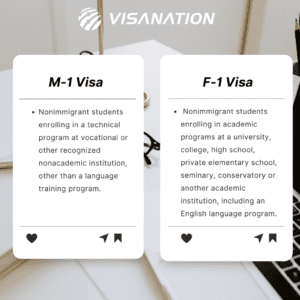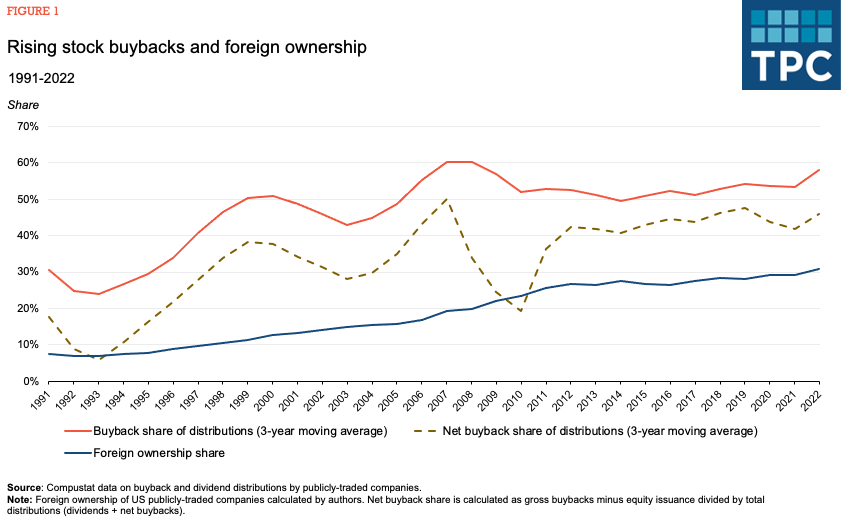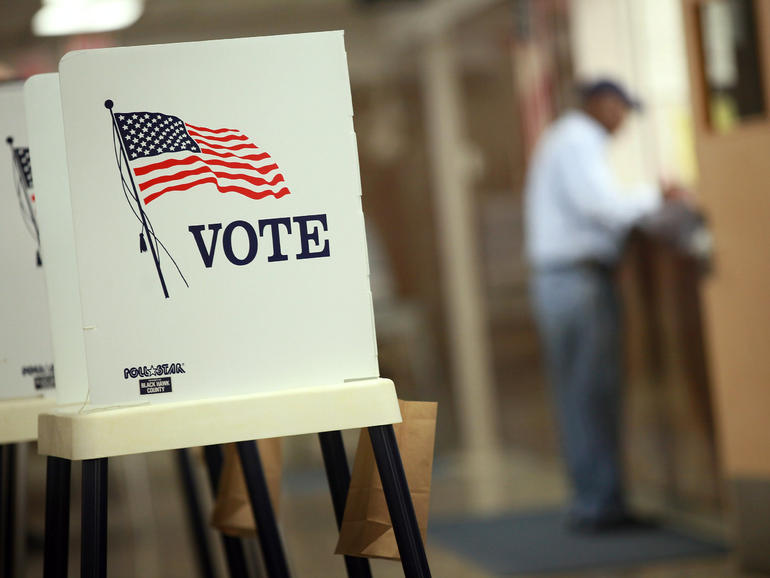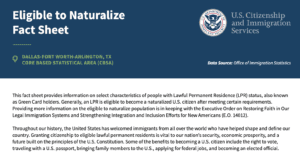M-1 Visa For Students in 2023: Cost and Work Permit
If you are a foreign national interested in pursuing a vocational or non-academic education/training in the United States, the M-1 Visa may be the right fit for you. This visa is not to be confused with the F Visa which is also a student visa but allows you to enter the United States to attend University, college, high school, private elementary school, seminary, conservatory or another academic institution including a language training program.
Different Types of Student Visas
As previously mentioned there are two main categories of student visas in the United States: F-1 and M-1.
- F-1 Visa – The F-1 visa is more common for students seeking to study in the United States. The requirements to obtain this visa include:
- Program must be an accredited academic educational program, a language-training program, or a vocational program.
- The student’s school needs to be accepted by the Student and Exchange Visitors Program as well as Immigration and Customs Enforcement.
- Must be enrolled full-time as a student
- Must be able to demonstrate proficiency in the English language or be enrolled in courses to learn proficiency
- Must have the funds to be financially independent during your studies
- Must not eliminate your residence overseas
- M-1 Visa – This visa is for international students who wish to pursue vocational or non-academic training at a U.S. institution. Examples of programs covered by the M-1 visa include courses in computer technology, culinary arts, aviation, cosmetology, and many more. M-1 visa holders can stay in the United States for the duration of their vocational or technical program, but they are not allowed to work while they are studying. The M-1 can be issued up to 365 days prior to the start date of your study course but you can only enter into the U.S. within 30 days of the start date. The M-1 visa USA requirements are as follows:
- Must be registered as a full-time student in a vocational or non-academic program
- Have a high level of proficiency in English or be currently taking English language classes
- Must be financially independent throughout your stay and have a residence outside of the United States
- The program must be sanctioned by the Student and Exchange Visitors Program (SEVP)
Keep in mind that for you to apply for the M-1 visa you need to first be enrolled in a vocational or other non-academic programs. After your receive your acceptance notice, you can then go through with the application process.
One important similarity between both visas is that the applicant has to show that they have intentions to return to their home country after their studies are completed (so be sure not to eliminate your residence back home).
M-1 Visa Application Process
The Student and Exchange Visitor Information System (SEVIS), which allows students from SEVP-approved programs to apply for student visas, requires you to pay the SEVIS I-901 fee after enrolling in a SEVP-approved program. Once you have registered with SEVIS, you will receive a Form I-20 (officially called a “Certificate of Eligibility for Nonimmigrant Student Status”) that you will need when applying for a visa. You can now apply for an M-1 visa at your local U.S. Embassy or consulate. The DHS allows I-20s to be signed and distributed electronically by Designated School Officials (DSOs).
The M-1 visa application process varies slightly at different embassies so it’s critical to first visit the site of your local U.S. Embassy or consulate for the exact guidelines.
- Fill out for DS-160, Online Nonimmigrant Visa Application
- Upload the necessary photographs per the State Departments regulations during the filing process
- Print the confirmation page which you will need for your interview
- It is mandatory for individuals between the ages of 13 and 80 to schedule an interview at a U.S. Embassy or consulate in their country of residence. There may be an applicable $160 application fee before your interview (depending on the embassy)
Be sure to have all the necessary documents ready with you including:
- Form I-20, signed by the official at your study program and yourself (if your spouse and/or children intend to reside with you in the United States while you study, they must obtain individual Form I-20s, but they do not pay the SEVIS fee.)
- Valid passport (must be still valid ix months after your intended date of entry).
- Confirmation page for Form DS-160
- Photos per the State Department’s requirements if you did not upload it when completing the DS-160
- Receipt for the application fee
Additional documents may be required. Discuss this with your qualified immigration attorney. If you are asked to bring documents of your academic qualifications, you may consider bringing:
Appointment wait-time tool on this USCIS page.
What Will the Interview Be Like?
As part of the interview, the consular officer will ask you questions to determine whether you are eligible for the M-1 student visa. Some embassy officers take digital fingerprints during the interview. Your visa may be issued with an issuance fee, depending on your location. There may be a need for more administrative processing in some cases. The officer will inform you if this is the case. In order to enter the United States, you will need your M-1 visa, passport, and Form I-20. The fact that you have a visa does not guarantee that you will be admitted to the country. Ultimately, this decision rests with the Custom and Border Protection (CBP) agent. If permitted to enter, the agent will either stamp your passport or give you a Form I-94 (otherwise known as an Arrival/Departure Record).
Grace Period for M-1
There is a 30-day grace period (begins right after your study course is complete and any authorized practical training is completed). This grace period should be used in order to prepare to leave the U.S. and return to your residence overseas OR to apply to transfer to a different institution if that is in your plan. Moreover, you can also apply to change your status to another non-immigrant visa. Discuss the best suitable option with your immigration attorney.
Can I Apply for an Extension of Stay?
You may be eligible for an extension of stay. These are granted for a cumulative period of up to 3 years (beginning from the original start date on Form I-20 plus the 30-day grace period). M-1 students may not be granted an extension if they cannot complete the course within three years after starting.
How to Qualify for an Extension
An M-1 student requesting an extension of stay must provide proof of financial responsibility for the entire extension period. A DSO will enter the request for an M-1 extension of stay on the student’s record in SEVIS if the DSO confirms that the student has an educational or medical justification for filing an extension.
The DSO will sign a new Form I-20 for the student after granting the request. USCIS must receive this updated form in order to extend the student’s stay.
*Note that an extension request must be made at least 60 days, but no later than 15 days, from the M-1 student’s program end date.
M-1 Visa Work Permit
After finishing your course of study, you can only work in temporary employment for practical training and the employment needs to be related to your course of study. You can apply for the EAD by filing Form I-765 accompanied by the approval of your designated school official “no more than 90 days before the program end date”. Employment authorization will be granted for one month for each four months of full-time study completed, not exceeding six months. Be aware that it is also possible to change your status to other visa options like H-1B or O-1.
Frequently Asked Questions
Below you will find answers to the most commonly asked questions about the topic.
Can I study on a B visa?
A visitor B visa allows you to enroll in a short recreational course of study (not for credit toward a degree or academic certificate).
Do I have to pay the visa issuance fee if my visa is not approved?
No, this fee is paid only if your visa is approved.
How long is an M-1 visa valid for?
The M-1 visa permits you to stay in the U.S. for one year, or for as long as you are enrolled in a vocational program plus thirty days to prepare to leave.
Can I work in USA with M-1 visa?
Yes, you can by filing Form I-765 accompanied by the approval of your designated school official “no more than 90 days before the program end date”.
What is the difference between M-1 and F-1 visa?
The F-1 visa is for students seeking to study in the United States for University, college, high school, private elementary school, seminary, conservatory or another academic institution including a language training program. The M-1 visa is for international students who wish to pursue vocational or non-academic training at a U.S. institution.
How long can an M-1 student stay in the U.S.?
Those who acquire M-1 status may remain in the United States until they complete their studies, as well as any authorized practical training.







